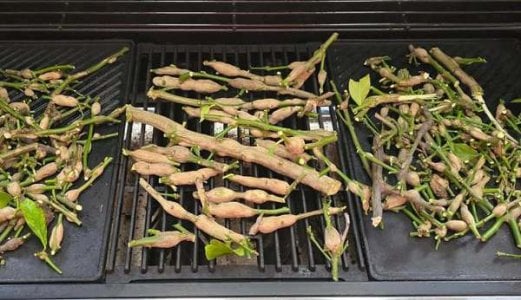Is Your Backyard at Risk? Shocking BBQ Photo Exposes Fast-Spreading Pest Invading Aussie Gardens!
By
Danielle F.
- Replies 3
As Australians, we take pride in our backyards, often considering them an extension of our homes where we can enjoy the great outdoors, tend to our gardens, and of course, fire up the BBQ for a classic cookout. However, a recent photo shared by a West Australian gardener has raised alarms about an unwelcome guest that could be lurking in your own backyard, threatening to disrupt this idyllic setting.
The image in question shows a BBQ piled with pruned branches from a neighbour's lemon tree, a seemingly innocent act of garden maintenance. But these branches were not trimmed for the sake of tidiness alone; they were infested with a pest that 'spreads very quickly and easily' – the citrus gall wasp.
To the untrained eye, the tree branches might look harmless, with peculiar bulbs growing within the stems. Yet, these unusual growths are a telltale sign of a citrus gall wasp infestation, a problem that targets citrus trees, particularly lemon and grapefruit, and can severely impact both the fruit production and the health of the trees.
'The citrus gall wasp is a native insect to Australia found on finger limes. Now, these wasps happily attack other citrus trees like oranges and lemons,' explained Professor Brett Summerell, Chief Scientist at the Botanic Gardens of Sydney, in a conversation with Yahoo. 'These wasps can reduce fruit production and can make citrus trees quite sick.'
Managing a citrus gall wasp infestation is crucial for the health of your citrus trees. The gardener who shared the images on Facebook explained that he assisted his neighbour in pruning the infected lemon tree. 'Nice weather for a BBQ. Helped neighbour prune lemon tree badly infested by citrus gall wasp. The galls are pruned out for a nice barbie,' he said, highlighting a common method of disposal – burning the infested branches.
Pruning is an effective control method that homeowners can easily undertake. However, caution is advised as wasps can still emerge from offcuts if pruned too close to their usual emergence period, which typically falls between September and December. To mitigate any risk associated with wasp-infected offcuts, burning is one option. Alternatively, shredding and mulching or sealing the branches in a bag can also be effective.
The optimal time to prune out galls is from April to June, before the wasps have a chance to emerge and spread.
The citrus gall wasp, originally from northern NSW and Queensland, has now become an established pest in most Perth suburbs, having spread across the country. First detected in WA in the Perth suburb of Eden Hill in 2013, it has since become a significant problem in the Perth metropolitan area and has also impacted South Australia and Victoria.
While the pest has not yet been found in commercial citrus orchards in Western Australia, according to the state's Department of Primary Industries and Regional Development, it remains a concern for home gardeners. The wasps lay their eggs in new shoots of citrus trees, and the tree responds by forming distinctive galls around the developing larvae, from which adult wasps eventually emerge.
These galls disrupt the flow of water and nutrients, weakening the trees and affecting their productivity. Heavy infestations can lead to reduced fruit size and quantity over time.
Professor Summerell recommends not just pruning the tree but also carefully slicing the top of the gall to expose and kill the wasp larvae. If you choose to prune the affected parts, it's crucial to dispose of them in a sealed bag to prevent the wasps from emerging later.
Our love for Australia's unique environment is undeniable, but it also comes with the responsibility of managing and protecting it from pests like the citrus gall wasp. By staying informed and taking proactive measures, we can continue to enjoy our gardens and the fruits of our labour without the unwelcome interference of invasive species.

Have you encountered the citrus gall wasp in your garden, or do you have other tips for managing garden pests? Share your experiences and advice in the comments below, and let's help each other keep our Aussie gardens healthy and thriving!
The image in question shows a BBQ piled with pruned branches from a neighbour's lemon tree, a seemingly innocent act of garden maintenance. But these branches were not trimmed for the sake of tidiness alone; they were infested with a pest that 'spreads very quickly and easily' – the citrus gall wasp.
To the untrained eye, the tree branches might look harmless, with peculiar bulbs growing within the stems. Yet, these unusual growths are a telltale sign of a citrus gall wasp infestation, a problem that targets citrus trees, particularly lemon and grapefruit, and can severely impact both the fruit production and the health of the trees.
'The citrus gall wasp is a native insect to Australia found on finger limes. Now, these wasps happily attack other citrus trees like oranges and lemons,' explained Professor Brett Summerell, Chief Scientist at the Botanic Gardens of Sydney, in a conversation with Yahoo. 'These wasps can reduce fruit production and can make citrus trees quite sick.'
Managing a citrus gall wasp infestation is crucial for the health of your citrus trees. The gardener who shared the images on Facebook explained that he assisted his neighbour in pruning the infected lemon tree. 'Nice weather for a BBQ. Helped neighbour prune lemon tree badly infested by citrus gall wasp. The galls are pruned out for a nice barbie,' he said, highlighting a common method of disposal – burning the infested branches.
Pruning is an effective control method that homeowners can easily undertake. However, caution is advised as wasps can still emerge from offcuts if pruned too close to their usual emergence period, which typically falls between September and December. To mitigate any risk associated with wasp-infected offcuts, burning is one option. Alternatively, shredding and mulching or sealing the branches in a bag can also be effective.
The optimal time to prune out galls is from April to June, before the wasps have a chance to emerge and spread.
The citrus gall wasp, originally from northern NSW and Queensland, has now become an established pest in most Perth suburbs, having spread across the country. First detected in WA in the Perth suburb of Eden Hill in 2013, it has since become a significant problem in the Perth metropolitan area and has also impacted South Australia and Victoria.
While the pest has not yet been found in commercial citrus orchards in Western Australia, according to the state's Department of Primary Industries and Regional Development, it remains a concern for home gardeners. The wasps lay their eggs in new shoots of citrus trees, and the tree responds by forming distinctive galls around the developing larvae, from which adult wasps eventually emerge.
These galls disrupt the flow of water and nutrients, weakening the trees and affecting their productivity. Heavy infestations can lead to reduced fruit size and quantity over time.
Professor Summerell recommends not just pruning the tree but also carefully slicing the top of the gall to expose and kill the wasp larvae. If you choose to prune the affected parts, it's crucial to dispose of them in a sealed bag to prevent the wasps from emerging later.
Our love for Australia's unique environment is undeniable, but it also comes with the responsibility of managing and protecting it from pests like the citrus gall wasp. By staying informed and taking proactive measures, we can continue to enjoy our gardens and the fruits of our labour without the unwelcome interference of invasive species.
Key Takeaways
- The BBQ photograph shared by the West Australian gardener highlights an invasive pest known as the citrus gall wasp, which is rapidly spreading in Aussie gardens.
- Citrus gall wasp causes serious damage to citrus trees like lemons and grapefruits by reducing fruit production and compromising tree health.
- Effective management includes pruning out the galls, particularly from April to June, and ensuring pruned branches are burnt, shredded, mulched, or sealed in bags to prevent wasp emergence.
- The citrus gall wasp is native to Australia and has spread to most Perth suburbs, with potential risks to both home gardens and commercial orchards.








